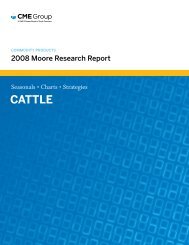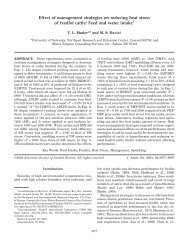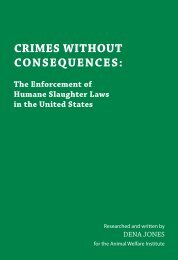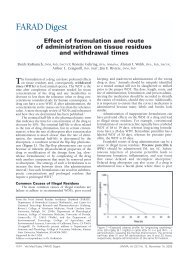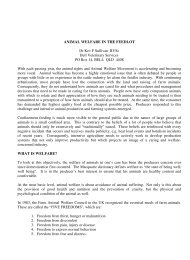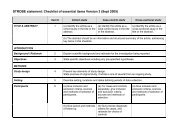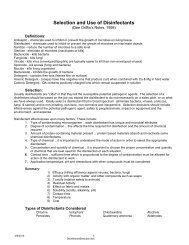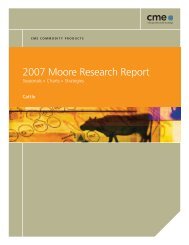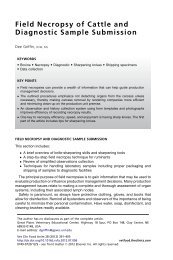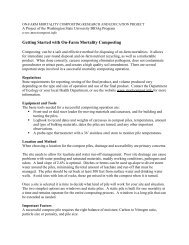Drylot Beef Cow/Calf Production AS-974 PDF
Drylot Beef Cow/Calf Production AS-974 PDF
Drylot Beef Cow/Calf Production AS-974 PDF
Create successful ePaper yourself
Turn your PDF publications into a flip-book with our unique Google optimized e-Paper software.
6<br />
so all cows get their share and that cows are<br />
in a securely fenced area.<br />
5. Table 3 is an example supplement (feed at 2<br />
pounds/cow/day).<br />
Ward et al. (2004) at South Dakota State University<br />
replaced alfalfa hay with increasing levels of dry-rolled<br />
barley to mid- and late-gestation cows from January<br />
to April. Control cows consumed 20 to 23.5 pounds<br />
of hay. The “low” barley treatment group consumed<br />
5.3 to 6.2 pounds of barley per day with 12.5 to 13.9<br />
pounds of hay. The “high” barley group ate 10.6 to<br />
12.6 pounds of barley plus 4.9 to 5.7 pounds of hay<br />
daily. A protein/trace mineral supplement was fed to<br />
all cows at 0.5 pound per head per day that provided<br />
200 milligrams of Rumensin per head. Both barley<br />
groups gained more weight and body condition<br />
than cows fed alfalfa with similar pregnancy rates<br />
observed during the following breeding season.<br />
Table 3. Supplement Formulation for<br />
High-grain <strong>Beef</strong> <strong>Cow</strong> Diet<br />
Ingredient Percent, DM Basis<br />
Ground corn 32.1<br />
Soybean meal 45.6<br />
Urea 4.1<br />
Limestone 7.8<br />
Dicalcium phosphate 4.3<br />
Trace mineral salt 3.2<br />
Dyna K (potassium) 2.3<br />
Selenium premix (200 ppm) .4<br />
Vitamin premix a .2<br />
Rumensin 80 b .12<br />
a Vitamin A, 15,000 IU/gram; Vitamin D, 1,500 IU/gram.<br />
b 192 mg Rumensin/hd/d.<br />
Supplement contains the following nutrients:<br />
Crude protein 36%<br />
Calcium 3.76%<br />
Phosphorus 1%<br />
NOTE: If using a commercial supplement, feed according to<br />
bag instructions.<br />
Alternative Feeds<br />
All potential feeds available in the region should be<br />
considered in drylot production. The conventional<br />
ones include corn, milo and sorghum silage; alfalfa<br />
hay and haylage; prairie hay; brome grass hay; millet<br />
hay; corn, milo and millet stover; cereal grain hay<br />
and straw; soybean meal; soybean hulls; canola and<br />
canola meal; sunfl owers and sunfl ower meal; fl ax;<br />
linseed meal; barley; barley malt; wheat; wheat mill<br />
run; corn gluten feed; distillers grains; condensed<br />
distillers solubles; fi eld peas; dry beans; oats;<br />
sorghum; and minor grains, such as rye and millet.<br />
Other feeds that are useful include potato processing<br />
products, beet pulp and tailings beet molasses and<br />
de-sugared molasses, screenings of all kinds, hulls of<br />
all kinds, food processing waste and several others. A<br />
number of studies at the NDSU Carrington Research<br />
Extension Center have focused on the usefulness<br />
of a wide variety of coproducts and new feed grains<br />
available in the region for the cow-calf and feedlot<br />
enterprises. The following briefl y describes some of<br />
the studies and results:<br />
Wet potato coproducts<br />
Lactating mature crossbred beef cows were fed<br />
high levels of wet potato coproduct (17 percent DM)<br />
which constituted 25 percent of dry-matter intake<br />
(DMI), wheat straw (45 percent of DMI), wheat midds<br />
(15 percent of DMI) and chopped alfalfa hay (15<br />
percent of DMI). Compared with corn silage-based<br />
diets, cows gained more weight and increased body<br />
condition score with the raw potato coproduct diet<br />
with no difference in conception rate.<br />
Barley malt or wheat midds<br />
Barley malt (25 percent of DMI) or wheat midds<br />
(22 percent of DMI) was included in lactating drylot<br />
mature beef cow diets with wet potato waste (54<br />
percent of DMI), straw (21 percent to 25 percent of<br />
DMI) and small amounts of alfalfa hay (12 percent of<br />
DMI) without negative effects. Conception rates were<br />
96 percent at fall pregnancy palpation. Wheat midds<br />
were fed at about 50 percent of DMI to lactating fi rstcalf<br />
heifers with straw at 32 percent of DMI and alfalfa<br />
at 18 percent of DMI with no observable difference,<br />
compared with the corn silage-alfalfa hay-based<br />
control ration.




